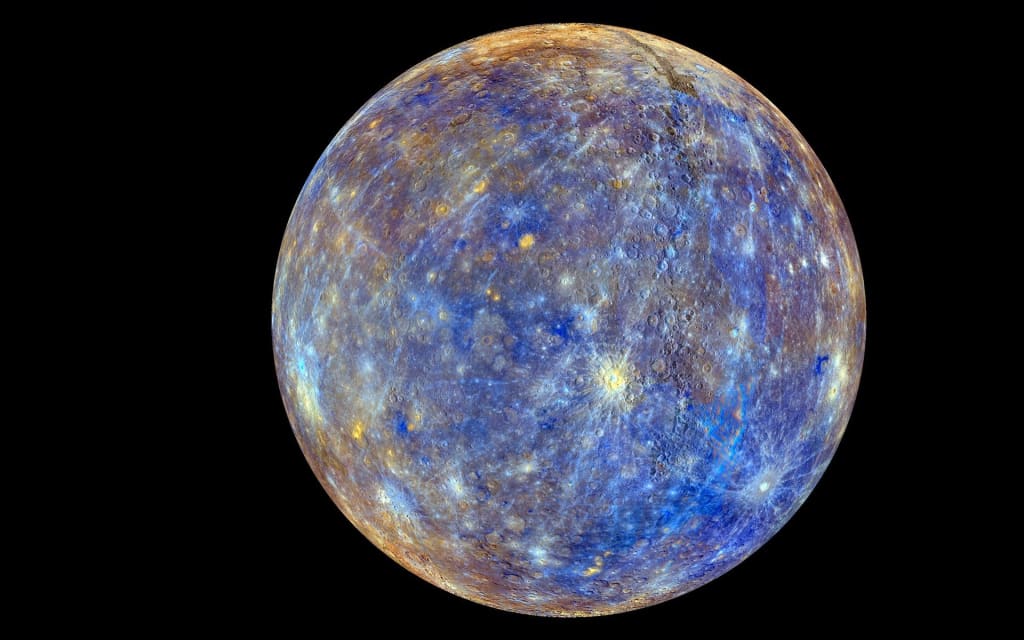
Mercury is the smallest planet in the solar system and the closest planet to the sun. It is named after the Roman messenger god Mercury, who was known for his speed and agility. Mercury is also known as "the Swift Planet" because it orbits the sun faster than any other planet, completing one orbit in just 88 Earth days.
Mercury also rotates very slowly on its axis, taking 59 Earth days to complete one rotation. This means that a day on Mercury (the time it takes for one rotation) is actually longer than a year on Mercury (the time it takes to complete one orbit around the sun).
Mercury is a rocky planet with a heavily cratered surface, similar to Earth's moon. It has a very thin atmosphere, which is composed mostly of helium and traces of other gases. Due to its proximity to the sun, Mercury experiences extreme temperature variations, with surface temperatures ranging from -290 degrees Fahrenheit (-180 degrees Celsius) at night to 800 degrees Fahrenheit (430 degrees Celsius) during the day.
Mercury has been visited by only one spacecraft, NASA's Messenger mission, which orbited the planet from 2011 to 2015. The mission provided scientists with valuable data about Mercury's surface, composition, and magnetic field. In addition to Messenger, several other spacecraft have flown by Mercury, including NASA's Mariner 10 mission in the 1970s.
Despite its small size and proximity to the sun, Mercury has played an important role in our understanding of the solar system and the formation of planets. Scientists continue to study Mercury to learn more about its geology, composition, and history, and to gain insights into the early stages of planetary formation.
Mercury has a magnetic field weaker than Earth's magnetic field. This magnetic field is thought to be generated by the planet's molten core, which is composed mostly of iron.
Mercury is the only planet in the solar system that has no moons or rings.
Despite its small size, Mercury is the second densest planet in the solar system, after Earth. This is due to its large iron core, which makes up about 75% of the planet's volume.
UNIQUENESS
Mercury has a very unusual orbit around the sun. Unlike most planets in the solar system, which have nearly circular orbits, Mercury's orbit is highly elliptical, meaning that it is more like an oval shape. This causes Mercury to experience significant variations in its distance from the sun, which in turn affects its surface temperature. When Mercury is closest to the sun, its surface can reach temperatures of up to 800 degrees Fahrenheit (430 degrees Celsius), while at its farthest point, temperatures can drop to -290 degrees Fahrenheit (-180 degrees Celsius). This extreme temperature variation is one of the many unique features of Mercury.
Mercury has a very thin atmosphere, which is composed mostly of helium and traces of other gases such as hydrogen, oxygen, and sodium. The atmosphere is so thin that it is often referred to as an exosphere, meaning that the gases are not held in place by gravity and instead disperse into space.
The thin atmosphere of Mercury is thought to be the result of several factors, including the planet's small size, low gravity, and proximity to the sun. The solar wind, which is a stream of charged particles emitted by the sun, also plays a role in stripping away Mercury's atmosphere.
The presence of sodium in the atmosphere, for example, has been detected by ground-based telescopes and spacecraft, and is thought to be the result of the vaporization of surface materials due to the extreme heat and radiation from the sun.
MERCURY IN ANCIENT HISTORY
Mercury, as a planet, has been observed and studied by humans for thousands of years, and has played an important role in many ancient cultures and mythologies around the world.
In ancient Roman mythology, Mercury was the god of commerce, communication, and travelers, and was often depicted wearing winged sandals and a winged hat. The planet Mercury was named after this god due to its fast orbit around the sun, which was seen as a reflection of the god's speed and agility.
In ancient Chinese astronomy, Mercury was known as Chen Xing, or the "Morning Star," and was associated with the element water and the direction north. It was believed to have a significant influence on human affairs and was often used in astrological predictions and divination.
In ancient Indian astronomy, Mercury was known as Budha, and was associated with the god of the same name. It was believed to have a strong influence on communication, intelligence, and learning, and was often used in astrological charts and predictions.
In ancient Greek astronomy, Mercury was known as Hermes, and was associated with the god of the same name. It was often depicted as a messenger, carrying messages between the gods and humans. The planet was also associated with the element earth and the direction north.
About the Creator
Captain Kidd
I am thrilled to invite you to an extraordinary adventure. A journey through the vast and mysterious realm of outer space, promises to be both educational and awe-inspiring, as we explore the wonders of the cosmos together.
Enjoyed the story? Support the Creator.
Subscribe for free to receive all their stories in your feed. You could also pledge your support or give them a one-off tip, letting them know you appreciate their work.






Comments
There are no comments for this story
Be the first to respond and start the conversation.